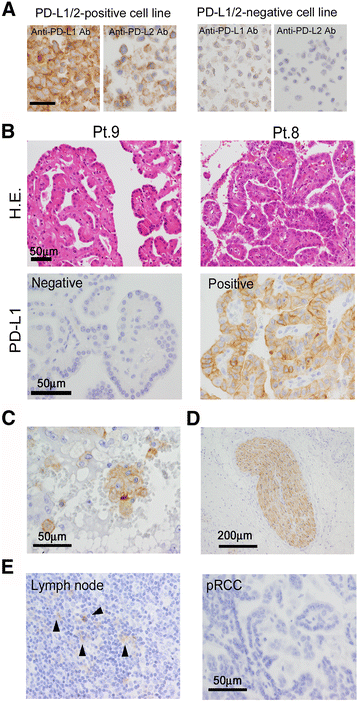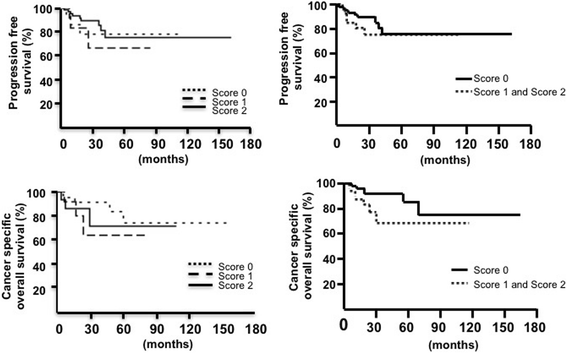PD-L1 expression in papillary renal cell carcinoma
- PMID: 28086852
- PMCID: PMC5237189
- DOI: 10.1186/s12894-016-0195-x
PD-L1 expression in papillary renal cell carcinoma
Abstract
Background: The immune escape or tolerance of cancer cells is considered to be closely involved in cancer progression. Programmed death-1 (PD-1) is an inhibitory receptor expressed on activating T cells, and several types of cancer cells were found to express PD-1 ligand 1 (PD-L1) and ligand 2 (PD-L2).
Methods: In the present study, we investigated PD-L1/2 expression in papillary renal cell carcinoma (pRCC).
Result: We found PD-L1 expression in 29 of 102 cases, but no PD-L2 expression was seen. PD-L1 expression was not significantly correlated with any clinicopathological factor, including progression-free survival and overall survival. The frequency of PD-L1-positive cases was higher in type 2 (36%) than in type 1 (22%) pRCC; however, there was no significant difference in the percentages of score 0 cases (p value = 0.084 in Chi-square test). The frequency of high PD-L1 expression cases was higher in type 2 (23%) than in type 1 (11%), and the frequency of high PD-L1 expression cases was higher in grade 3/4 (21%) than in grade 1/2 (13%). However, no significant association was found between PD-L1 expression and all clinicopathological factors in pRCC.
Conclusion: High expression of PD-L1 in cancer cells was potentially associated to highly histological grade of malignancy in pRCC. The evaluation of the PD-L1 protein might still be useful for predicting the efficacy of anti-cancer immunotherapy using immuno-checkpoint inhibitors, however, not be useful for predicting the clinical prognosis.
Figures



References
-
- Albiges L, Guegan J, Le Formal A, Verkarre V, Rioux-Leclercq N, Sibony M, et al. MET is a potential target across all papillary renal cell carcinomas: result from a large molecular study of pRCC with CGH array and matching gene expression array. Clin Cancer Res. 2014;20:3411–3421. doi: 10.1158/1078-0432.CCR-13-2173. - DOI - PubMed
MeSH terms
Substances
LinkOut - more resources
Full Text Sources
Other Literature Sources
Medical
Research Materials

